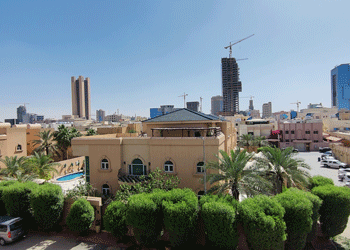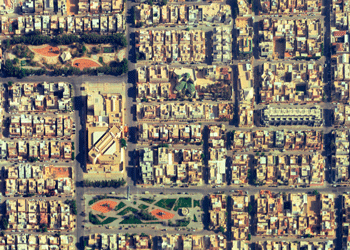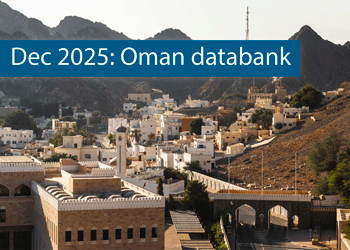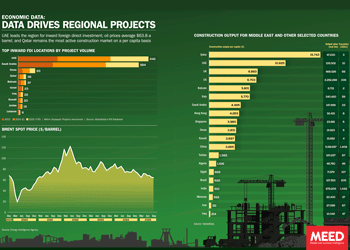Acquisition with a view to transition
24 October 2024

Adnoc International’s $16.3bn bid for German plastics group Covestro, signed on 1 October, has called fresh attention to the Middle East and North Africa (Mena) region as a source of merger and acquisition (M&A) activity.
The deal by the UAE state energy company’s overseas business arm, which is the largest Mena deal of the year, is just one of a string of acquisitions by regional energy companies seeking to diversify both sectorally and in terms of geography. And energy – notably the low-carbon variant – has emerged as a key focus for buyers.
Within the Mena region, the GCC remains the mainstay of deal flow, with its clutch of sovereign wealth funds (SWFs) and government-related entities (GREs) underpinning activity through transformative agendas that are shaped by government-led ambitions to shift away from oil and gas and embrace newer areas of the economy.
The figures underscore the Gulf bias in M&A deal flow. Ten of the Mena region’s highest-valued M&As in the first six months of 2024 were concentrated in the GCC region.
The UAE and Saudi Arabia saw a combined 152 deals worth $9.8bn and were among the top Mena bidder countries in terms of deal volume and value, according to data from EY.
The largest transaction came in February, when private equity firms including Clayton Dubilier & Rice, Stone Point Capital and Mubadala Investment announced the acquisition of Truist Insurance Holdings, the US’s fifth-largest insurance brokerage, for $12.4bn – a sign that Gulf entities have the appetite and balance sheet to lock down opportunities in North America.
Indeed, according to EY, the US remained the preferred target destination for Mena outbound investors in the first half of 2024, with 19 deals amounting to $16.6bn.
Meanwhile, Gulf-based SWFs dominate in regional M&A activity in terms of deal value. Consultancy Bain & Company says they represented 86% of deal value in 2023, either directly or through portfolio companies.
Industrial focus
Sector-specific drivers have come to the fore for some participants, and that is evident in the spread of M&A activity. Take Saudi Arabia’s Public Investment Fund (PIF), which acquired steel companies Al-Rajhi Steel and Hadeed last year, from Rajhi Invest and Saudi Basic Industries Corporation, respectively, creating a national champion in a domestic steel sector that has consolidated.
Similarly, Adnoc’s Covestro acquisition confirms the prominent role that national oil companies continue to play as they morph into energy companies with more diverse product slates, and in turn are required to grow inorganically at times.
The Covestro deal represents a similar move to the PIF’s steel sector play last year. The German company would become a key plank in Adnoc’s ambition to create a speciality chemicals business. In a similar way, Borealis, in which Adnoc is a minority stakeholder, acquired Austrian chemicals group Integra Plastics in a deal announced in April 2024.
“The acquisitions from Adnoc are in line with a vision that they set out [in 2017], when the company restructured and broadened its scope to be a global business, looking actively for global opportunities to grow and diversify,” says Alice Gower, a partner at Azure Strategy.
She says that the interest in the European downstream sector is “a really smart move, because it not only ensures a market for their products, but it replaces Russian supplies and creates a dependency between Europe and, in this case, the Saudis or Emiratis”.
UAE companies’ interest in buying into European industrial firms has been evident this year. February saw Adnoc complete its long-running effort to acquire a 24.9% stake in Austrian petrochemicals firm OMV, and in May, state held Emirates Global Aluminium completed the acquisition of German aluminium recycling firm Leichtmetall Aluminium Giesserei Hannover.
Another geographic theme has seen GCC firms target Asia and Africa – the latter increasingly a focus in terms of its resource opportunity, as well as its capacity to provide a growing consumer market with an emergent middle class.
Last year, Asia figured in some of the biggest deals involving Mena companies, such as the $2bn investment by the UAE’s Mubadala in Chinese fashion retail firm Shein, and Qatar Investment Authority’s purchase of a $1bn stake in India’s Reliance Retail Ventures.
Resources – particularly transition minerals – look set to remain a prominent theme for Mena dealmakers. In Africa, the UAE’s International Resource Holding, an affiliate of Sheikh Tahnoon Bin Zayed-headed International Holding Company, completed its acquisition of Zambia’s Mopani Copper Mine in March 2023, paying $1.1bn for a 51% stake. The UAE firm has moved into critical metals and sees this entity as playing a key role in developing the metal and mining supply chain.
Energy transition
The energy transition will continue to push Gulf acquirers’ M&A agendas.
Abu Dhabi’s Masdar, eyeing a target 100GW of clean energy by 2030, has become an active M&A player. In June, it acquired a 67% stake in Greek company Terna Energy for $2.9bn.
Deal flow at Masdar has been brisk, with a deal struck in September to acquire renewable energy provider Saeta Yield from US investment firm Brookfield for $1.4bn, handing it significant power assets in Spain and Portugal and a 1.6GW development pipeline.
Masdar has also been growing its US foothold, closing a deal in October for a 50% stake in US renewables company Terra-Gen, which boasts a wind, solar and battery storage portfolio of 3.8GW.
Meanwhile, with the PIF and Mubadala both committed to net-zero targets by 2050, in addition to working to decarbonise their existing portfolios, the funds are investing in green assets and in technologies that support decarbonisation, notes Bain & Company.
Azure Strategy’s Gower cautions against reading too much into the professed diversification agenda, however.
“Everybody talks about diversification, but if you actually look at what they’re investing in, it’s not that far from the fossil fuel industry,” she says.
“There is a vertical integration logic: you’re upstream and you want to then become more involved in midstream and downstream – that makes sense. But the businesses that they are buying are pretty low-margin, so there has to
be a different reason behind this approach.”
Instead, defensive motivations are in play. “It is about capturing shares in assets across different markets in order to spread risk, and then diversifying revenue streams away from direct exports, given their geographic location,” she says.
“Look at what is going on in the region at the moment, and the increase in shipping costs, the instability and insecurity risk.”
Banking mergers
M&A in the Mena banking sector has slowed down in the past five years, following a spate of deals that mainly reflected the reordering of state holdings in large Gulf banks.
In March 2024, the Egyptian subsidiary of Bahrain’s Bank ABC completed its merger with the Egyptian subsidiary of Lebanon’s Blom Bank, tripling Bank ABC’s market share in Egypt.
Market speculation is now centring on consolidation within Kuwait’s banking sector.
The proposed merger of Boubyan Bank and Gulf Bank – Kuwait’s third- and fifth-largest lenders – would create an Islamic lender with assets of about $53bn.
“GCC banks in general have been keeping their options open because these are small, concentrated economies and markets, and therefore international expansion will help diversify business models and improve profitability,” says Redmond Ramsdale, senior director for banks at Fitch Ratings.
M&A moves have taken Gulf banks into the wider region.
“External growth is part of some GCC banks’ strategy to diversify business models and improve profitability,” says Ramsdale. “By deploying capital into high-growth markets, they may be able to compensate for weaker growth in their home markets.”
In the wider Mena region, M&A activity in 2025 will be driven by the big regional SWFs and GREs. The need to decarbonise their portfolios will shape inorganic growth strategies as they look to buy lower-carbon assets ‘off the shelf’ to meet net-zero and emission-reduction targets.
With sizeable acquisition budgets at their disposal, these players do not lack the financial firepower to target assets that will help them meet their goals.
Exclusive from Meed
-
 Investors focus on residential sector for new deals
Investors focus on residential sector for new deals29 December 2025
-
 Saudi real estate to surge in 2026
Saudi real estate to surge in 202629 December 2025
-
 Navigating financial markets amid geopolitical fragmentation
Navigating financial markets amid geopolitical fragmentation28 December 2025
-
 Oman’s growth forecast points upwards
Oman’s growth forecast points upwards24 December 2025
-
 December 2025: Data drives regional projects
December 2025: Data drives regional projects23 December 2025
All of this is only 1% of what MEED.com has to offer
Subscribe now and unlock all the 153,671 articles on MEED.com
- All the latest news, data, and market intelligence across MENA at your fingerprints
- First-hand updates and inside information on projects, clients and competitors that matter to you
- 20 years' archive of information, data, and news for you to access at your convenience
- Strategize to succeed and minimise risks with timely analysis of current and future market trends

Related Articles
-
 Investors focus on residential sector for new deals
Investors focus on residential sector for new deals29 December 2025

This package also includes: Saudi real estate to surge in 2026
A series of legislative changes were made in 2025 to facilitate further growth of the sector in 2026
Saudi Arabia’s real estate market continued to gather momentum at the Cityscape Global 2025 event, with a record SR237bn ($63.1bn) of deals signed.
The event was held on 17-20 November at the Riyadh Exhibition & Convention Centre and was inaugurated by Saudi Municipalities & Housing Minister Majed Al-Hogail.
Although the deals signed at the event signalled a modest increase in dollar terms from the $61bn reported in 2024, they underline a steady increase in commitments to Saudi Arabia’s wider ecosystem of tourism, healthcare, logistics and supporting infrastructure schemes.
A large share of the $63.1bn is tied to the development of housing and residential communities, reflecting continued policy support for home ownership and urban expansion. Tourism- and infrastructure-related agreements also featured heavily.
NHC signings
The headline of the event was the series of agreements worth billions of dollars signed by Saudi Arabia’s National Housing Company (NHC) with many local and international firms.
The company signed two agreements worth over SR8.5bn ($2.2bn) for the development of two mixed-use and residential communities in Riyadh. The first agreement, worth over SR5.2bn ($1.4bn), was signed with local developer Retal Urban Development Company for a total of 4,839 residential units in the Al-Fursan suburb of Riyadh.
The other contract, worth over SR3.3bn ($880m), was signed with a joint venture of Egypt’s Hassan Allam Holding and local developer Tilal Real Estate for a mixed-use project in the Khozam district. The development will cover over 228,000 square metres (sq m).
The headline of the event was the series of agreements … signed by Saudi Arabia’s NHC
NHC also signed an investment agreement worth over SR1bn ($266m) with Turkiye’s Emlak Konut to develop residential communities within the Mecca Gate project in Mecca. Emlak Konut will develop 1,000 residential villas.
A SR2.64bn ($702m) partnership agreement was also announced with Egyptian real estate developer Mountain View to launch a residential project in the Al-Fursan suburb in Riyadh. The development will span 930,000 sq m and comprise 1,923 units.
NHC also signed agreements with local developers. It inked a deal with Ledar Company to develop over 930 units within the Dar Makkah project in Wujhat Bawabat, Mecca, valued at SR899m ($240m), and another with Dar Wa Emaar Company for 2,843 units in Wujhat Al-Fursan, worth more than SR3.3bn ($879m).
A deal with Ezdihar Real Estate will deliver a further 1,120 units in Wujhat Al-Fursan, valued at over SR880m ($234m).
NHC also announced a SR600m ($160m) deal with Al-Omar Investment to develop 14,000 residential units at the Dama Al-Mashriqya project in East Riyadh.
A SR525m ($140m) contract was awarded to local firm Zaid Alhussain & Brothers Group for infrastructure works in the Khuzam area north of Riyadh, while Saleh Abdulla Almahana Company secured a SR651m ($173m) contract to build 1,290 units for the Rose House project in Al-Ahsa.
NHC also awarded Riyadh-based Alomaier Trading & Contracting Company a contract to carry out infrastructure works at its Khuzam residential development in Riyadh. The scope of work covers all infrastructure works across an area of 4 million sq m.
NHC also announced the construction of 1,085 villas within the Al-Ghoroub project in Medina.
More announcements
NHC’s signings were complemented by further deals announced by major developers and government entities.
> Diriyah: Saudi gigaproject developer Diriyah Company awarded two construction contracts with a combined value of over SR5.7bn ($1.5bn) on the sidelines of the event.
The first, valued at about $800m, was awarded to the local BEC Arabia Contracting Company for the construction of offices in the Media and Innovation district of the Diriyah development. Within the same district, BEC Arabia will also build residential assets on the Manazel Al-Hadawi plots.
The other contract, estimated to be worth $900m, was awarded to local firm Almabani General Contractors for the main construction works on King Khalid Road.
> King Salman Park: The King Salman Park Foundation, Ajdan Real Estate and Sedco Capital announced a partnership agreement to build a SR3.8bn ($1bn) mixed-use real estate project within King Salman Park in Riyadh. The project will feature over 600 residential units, 200 hotel rooms, 45,000 sq m of office space and retail and service facilities covering 106,000 sq m.
> Urubah Investment: Local firm Urubah Investment unveiled a 53-floor residential and commercial tower in Riyadh’s Al-Yasmin district, with a built-up area of 160,000 sq m.
> Zood Real Estate: The firm announced the launch of a 10-tower mixed-use project on Riyadh’s Northern Ring Road.
> Ajdan Real Estate: The developer launched the Ajdan Infiniti complex and signed a financing agreement with Alawwal Bank. It also launched the Ajdan Towers project in Riyadh.
> Masar: Jeddah-based Masar sold three plots of land in its Masar Destination in Mecca for the construction of residential and hotel towers, with investments reaching SR1.6bn ($426m). It also signed an agreement for two plots for the development of two residential towers, with investments exceeding SR1bn ($266m).
Masar also signed a land sale deal for a 500-unit hotel tower, with total investments exceeding SR1bn ($266m), and a SR700m ($186m) land reservation agreement with Al-Diyar Al-Arabiya to develop a 300-unit residential tower.
> Mohammad Al-Habib: The developer launched a $1.3bn mixed-use project in the north of Riyadh.
> Al-Awaly: Jizan-based firm Al-Awaly announced signing a contract to establish Jazan Water City on an area of 114,000 sq m with an investment value of SR200m ($52m).
> Alothaim: The firm announced the launch of three mixed-use projects in Dammam, Medina and Khamis Mushait.
> Al-Majdiah Development: The firm signed a memorandum of understanding (MoU) with Alinma Bank to develop financing solutions that support its future projects.
> Roshn Group: The Saudi gigaproject developer signed partnership agreements for educational and residential developments and the localisation of supply chains. These include an MoU with the UK’s Cognita Schools to develop a private school in its Sedra residential community in Riyadh.
On the residential side, Roshn launched Sedra Residence, the construction contract for which has been awarded to Building Construction Company.
Roshn was also granted the first instant licence for off-plan sales projects.
In addition, local developer Maskan purchased land in Roshn’s Al-Arous community in Jeddah. Maskan will develop a mixed-use project at an investment of SR1.7bn ($453m).
> Sedco Capital: The firm signed agreements to develop a 540-unit residential complex and a 200-unit residential tower, with total investments of SR1.8bn ($479m). Sedco also signed a deal to develop a Courtyard by Marriott-branded hotel with 1,100 rooms within the Masar Destination in Mecca.
> Saudi Real Estate Refinance Company: The firm signed an agreement with Al-Rajhi Bank to purchase two real estate financing portfolios worth SR10bn ($2.6bn).
> Osus Real Estate: The developer launched two mixed-use projects in the Al-Malqa and Al-Qayrawan districts of Riyadh, with a total investment of about SR3bn ($800m).
> Liwan Real Estate: The firm launched a 151,300 sq m project comprising 2,500 residential units, along with a hotel, offices and commercial facilities, at an investment of SR4.5bn ($1.2bn).
> Kooheji Developments: The firm launched a three-tower development with 1,250 units, located in Al-Khobar.
> Bank Albilad: The bank launched a SR4.4bn ($1.1bn) fund to develop a mixed-use project in the Qurtuba district of Riyadh.
> SAB Invest: Together with Dallah Health and Aljazira Capital, SAB Invest will develop medical, commercial and hotel facilities near Dallah Al-Nakheel Hospital in Riyadh at an investment of SR1.2bn ($319m).
> Heyazah: The firm announced a mixed-use project spanning 103,000 sq m in the vicinity of King Salman Park in Riyadh.
> Riyad Capital: The investment company launched a SR1.7bn ($453m) fund to develop the One Mountain View project, featuring over 500 villas in the north of Riyadh.
> Al-Basateen: The developer launched the Al-Basateen Tower project at the intersection of Riyadh’s Northern Ring Road and King Fahd Road.
> Alinma Bank: The bank launched a fund worth SR3bn ($800m) to develop 2.7 million sq m of land in the Al-Janadriyah district of Riyadh.
https://image.digitalinsightresearch.in/uploads/NewsArticle/15269407/main.gif -
 Saudi real estate to surge in 2026
Saudi real estate to surge in 202629 December 2025

This package also includes: Investors focus on residential sector for new deals
Deals worth $63.1bn were signed at the Cityscape Global 2025 property show in Riyadh
After nearly a decade of Saudi sovereign wealth vehicle the Public Investment Fund (PIF) taking on the delivery burden of the kingdom’s largest projects, Riyadh is now turning to private sector real estate developers to help deliver its ambitions.
The shift reflects both opportunity and necessity. The PIF-led model has enabled Saudi Arabia to fast-track its gigaprojects and anchor Vision 2030’s transformation objectives. Riyadh is now looking for the private sector to maintain this momentum.
Opening the market
To encourage more real estate activity, the kingdom’s long-awaited foreign ownership law was approved in August 2025. It will come into force in early 2026 after a 180-day implementation period. It introduces a comprehensive structure for non-Saudi ownership of real estate.
 The law allows non-Saudi individuals and companies to own, lease and use property in designated areas, subject to restrictions by type and location. Foreign residents can own one home for personal use outside restricted zones, excluding Mecca and Medina.
The law allows non-Saudi individuals and companies to own, lease and use property in designated areas, subject to restrictions by type and location. Foreign residents can own one home for personal use outside restricted zones, excluding Mecca and Medina. Meanwhile, companies with foreign shareholders can acquire real estate across the kingdom, including in Mecca and Medina, provided it is for business purposes or employee housing and in line with financial regulations.
The intention is to help Saudi Arabia tap into international property demand – as Dubai has done – to boost foreign direct investment (FDI).
In 2024, the kingdom attracted SR119bn ($31.7bn) in FDI, up 24% year-on-year and 37% above earlier estimates, but still short of the $100bn annual target for 2030.
Manufacturing led inflows with SR35bn, followed by wholesale and retail trade, construction and financial and insurance services. Real estate did not feature among the top-performing sectors, underlining the potential for growth.
Land and finance
While the foreign ownership law focuses on demand, the revised white land tax regime, effective from 22 August 2025, targets supply. The law aims to curb land hoarding, boost urban land availability and support development priorities.
Key provisions include an annual white land tax of up to 10%, with zones graded between 10% and 2.5%; a vacant building fee of up to 5%, potentially rising to 10%, subject to approval by Saudi Arabia’s Council of Ministers; and the classification of cities according to supply-demand conditions and development needs.
The white land tax is likely to have a dual effect. It should prompt some landowners to bring idle plots into development, sell to active developers or enter into partnerships, thereby alleviating a long-standing structural bottleneck in Riyadh and other major cities. At the same time, it introduces a new cost for holding undeveloped land, which will need to be priced into feasibility studies and could initially push some asking prices higher as owners seek to pass on part of the burden.
Over time, if enforcement is seen as consistent and predictable, the white land tax could help normalise more active land markets and support the private sector’s expanded delivery role. But 2026 is likely to be a transitional year, with a mix of opportunistic sales, legal challenges and recalibrated land valuations.
The government has also intervened directly in the rental market, most notably with a rent freeze in Riyadh.
In response to double-digit rent increases in some districts, driven by non-oil growth, gigaprojects and corporate relocations, the authorities have imposed a five-year suspension of annual rent increases for residential and commercial leases in the capital.
For tenants, the freeze offers immediate relief and increases predictability, particularly for middle-income households and small businesses exposed to volatile rents. It also serves as a counterweight to fears that opening the market to foreign buyers in 2026 will drive another surge in rental prices.
For investors and developers, however, the impact is more challenging. Compressed rental growth in Riyadh reduces the upside on income-producing assets, especially where financing structures assumed steady nominal increases.
Running alongside these regulatory reforms is a quieter but significant development in real estate finance: the launch of Saudi Arabia’s first residential mortgage-backed securities by PIF subsidiary the Saudi Real Estate Refinance Company. This new asset class aims to enhance liquidity in the housing finance market and diversify investment opportunities.
In the longer term, a thriving, diversified real estate sector underpinned by such instruments can support the development of a broader ecosystem of mortgage issuers, servicers and investors, reducing systemic risk and broadening access to housing finance.
As the kingdom takes deliberate steps to open its market to foreign buyers, mobilise idle land, protect tenants and strengthen financial infrastructure, much will depend on execution. If the new foreign ownership rules are applied effectively, 2026 could mark the start of a more sustainable, private sector-led growth phase. If not, uncertainty could dampen the very investment the reforms aim to attract.
https://image.digitalinsightresearch.in/uploads/NewsArticle/15279545/main.gif -
 Navigating financial markets amid geopolitical fragmentation
Navigating financial markets amid geopolitical fragmentation28 December 2025

As we move towards 2026, geopolitical fragmentation is no longer a background risk that occasionally disrupts markets.
It has become a defining feature of the global financial landscape. Shifting alliances, persistent regional tensions, sanctions and the reconfiguration of supply chains are reshaping how capital flows, how liquidity behaves and how confidence is formed.
For firms operating in the Middle East, this does not simply mean preparing for more volatility. It means operating in a system where the underlying rules are evolving.
For much of the past three decades, businesses and investors worked within a broadly convergent global framework. Trade expanded, financial markets deepened and policy coordination – while imperfect – created a sense of predictability. That environment has changed.
Today, economic decisions are increasingly influenced by strategic alignment, security considerations and political resilience. Markets still function, but they do so in a more fragmented and less forgiving way.
Shifting landscape
One of the most important consequences of this shift is that risk no longer travels along familiar paths. In the past, geopolitical events were often treated as temporary shocks layered onto an otherwise stable system.
Today, they shape the system itself. Trade flows are influenced as much by political compatibility as by cost efficiency. Supply chains, once optimised for speed and scale, are reorganising into regional or allied clusters. Financial markets respond not only to data, but to narratives about stability, alignment and long-term credibility.
This change places greater pressure on firms that rely on historical relationships to guide decisions. Models built on past correlations – between interest rates and equity markets, or between energy prices and regional growth – are less reliable when markets move between different regimes. The challenge is not simply higher volatility, but the fact that correlations themselves can shift quickly.
Monetary policy adds a second layer of complexity. Major central banks are no longer moving in step. The US, Europe and parts of Asia face different inflation dynamics and political constraints, leading to diverging interest-rate paths.
For the GCC, where currencies are largely pegged to the US dollar, this divergence has direct consequences. Local financial conditions are closely tied to decisions taken by the Federal Reserve, even when regional economic conditions follow a different cycle.
This matters because funding costs, liquidity availability and hedging conditions are shaped by global rather than local forces. When US policy remains tight, dollar liquidity becomes more selective. When expectations shift abruptly, market depth can disappear quickly.
For firms with international exposure, long-term investment plans, or reliance on external financing, these dynamics require careful management. They cannot be treated as secondary macro considerations.
Energy markets further complicate the picture. The Middle East remains central to global energy supply, which means geopolitical events often interact with oil prices and financial conditions at the same time.
When shifts in energy expectations coincide with changes in global interest-rate sentiment, liquidity conditions can tighten rapidly. This interaction is well known in academic research on fixed exchange-rate systems, but its practical implications are often underestimated in corporate planning.
Expanding vulnerabilities
These dynamics expose clear vulnerabilities. Concentrated supply chains are more susceptible to disruption. Financing structures dependent on continuous market access are more exposed to sudden repricing. Risk management approaches that assume stable relationships between assets are more likely to disappoint. Operational risks – particularly in technology and data – are increasingly shaped by geopolitical considerations rather than purely technical ones.
At the same time, the region enters 2026 from a position of relative strength. GCC economies benefit from fiscal buffers, long-term investment programmes and a growing perception of stability compared to other parts of the world. In an environment where uncertainty is widespread, predictability itself becomes valuable. Capital increasingly seeks jurisdictions that combine economic ambition with institutional credibility.
The question, therefore, is not whether opportunities exist, but whether firms are prepared to capture them responsibly. This requires a shift in how future risks are assessed and embedded into decision-making. Linear forecasts and static plans are insufficient when the environment itself can change state. Scenario thinking must evolve beyond optimistic and pessimistic cases to reflect different combinations of geopolitical alignment, monetary conditions, and supply-chain stability. These scenarios should inform capital allocation, not sit in strategy documents.
Liquidity and risk management discipline also become central. In both trading and corporate finance, experience shows that many failures stem not from being wrong on direction, but from being overexposed when conditions change. Scaling risk to market conditions, maintaining funding flexibility and understanding how quickly liquidity can evaporate are essential practices. This is as true for corporate balance sheets as it is for trading books.
Operational resilience must be viewed through the same lens. Supply-chain redundancy, cybersecurity preparedness and data governance are no longer purely operational concerns. They influence financial stability, investor confidence and regulatory trust. In a fragmented world, operational disruptions can quickly translate into financial and reputational damage.
Facing the future
As we approach 2026, leadership in the Middle East faces a clear test. The global environment is unlikely to become simpler or more predictable. Firms that continue to rely on assumptions shaped by a different era will find themselves reacting rather than positioning. Those that invest in disciplined risk management, flexible planning and operational resilience will be better placed to navigate uncertainty and to turn volatility into strategic advantage.
In this environment, risk management is not an obstacle to growth. It is the framework that makes sustainable growth possible.
Ultimately – and this is an often overlooked critical point – none of these adjustments, whether in scenario planning, liquidity discipline, or operational resilience, can be effective without the right human capital in place.
Geopolitical fragmentation and financial volatility are not risks that can be fully addressed through models or policies alone. They require informed judgement, institutional memory and the ability to interpret weak signals before they become material threats or missed opportunities.
Firms that succeed in this environment will be those that deliberately invest in corporate knowledge: building internal capabilities where possible and complementing them with external expertise where necessary. This means involving professionals with the right background, cross-market experience and a proven, proactive approach to risk awareness and governance.
In a fragmented world, competitive advantage increasingly depends not only on capital or strategy, but on the quality of people entrusted with understanding risk, challenging assumptions and guiding decision-making under uncertainty.
 https://image.digitalinsightresearch.in/uploads/NewsArticle/15306336/main.gif
https://image.digitalinsightresearch.in/uploads/NewsArticle/15306336/main.gif -
 Oman’s growth forecast points upwards
Oman’s growth forecast points upwards24 December 2025

MEED’s January 2026 report on Oman includes:
> COMMENT: Oman steadies growth with strategic restraint
> GVT & ECONOMY: Oman pursues diversification amid regional concerns
> BANKING: Oman banks feel impact of stronger economy
> OIL & GAS: LNG goals galvanise Oman’s oil and gas sector
> POWER & WATER: Oman prepares for a wave of IPP awards
> CONSTRUCTION: Momentum builds in construction sectorTo see previous issues of MEED Business Review, please click herehttps://image.digitalinsightresearch.in/uploads/NewsArticle/15306449/main.gif -
 December 2025: Data drives regional projects
December 2025: Data drives regional projects23 December 2025
Click here to download the PDF
Includes: Top inward FDI locations by project volume | Brent spot price | Construction output
MEED’s January 2026 report on Oman includes:
> COMMENT: Oman steadies growth with strategic restraint
> ECONOMY: Oman pursues diversification amid regional concerns
> BANKING: Oman banks feel impact of stronger economy
> OIL & GAS: LNG goals galvanise Oman’s oil and gas sector
> POWER & WATER: Oman prepares for a wave of IPP awards
> CONSTRUCTION: Momentum builds in construction sectorTo see previous issues of MEED Business Review, please click herehttps://image.digitalinsightresearch.in/uploads/NewsArticle/15306140/main.gif

